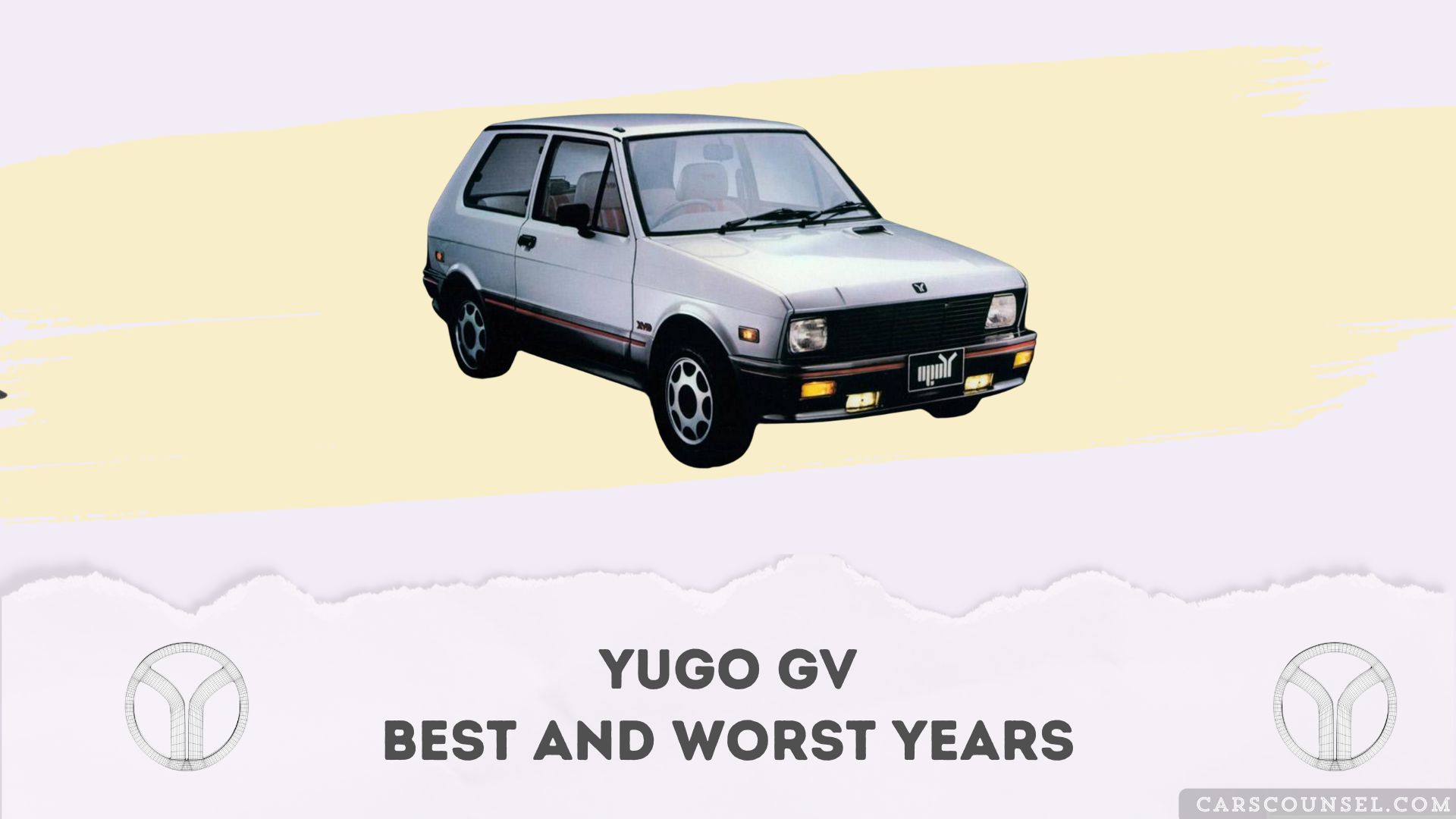Imagine buying a car in 1984 that sparks articles in prominent newspapers, with critics praising its affordability. That’s what happened with the Yugo GV, but its initial interest was short-lived.
As you’re about to find out, the Yugo GV’s quality issues, poor performance, and maintenance problems soon overshadowed its debut, earning it a spot as one of the worst ever made. What led to its downfall, and how did it gain a cult following?

Quick Navigation
Key Takeaways
- The Yugo GV’s best years were 1984-1985, with initial interest and relatively few quality issues.
- The worst years were 1986-1989, marked by criticism, poor performance, and maintenance issues.
- 1989 was particularly infamous, with a Yugo GV crashing into a fountain at a Car and Driver event.
- By 1988, sales had fallen off a cliff, with dealerships offering buy-one-get-one-free deals that customers still refused.
- The company ultimately went bankrupt in 1989 due to a lack of buyers, even at low prices.
The Rise of the Yugo
As the automotive world buzzed with excitement, Miro Kefurt’s vision to bring the Yugo to the United States finally took shape in 1982.
You see, Kefurt reached out to Zastava’s Yugoslavian manufacturer, to export the Yugo 45 to the US market.
Fast forward to 1984, the Los Angeles Auto Show debuted the Yugo GV, priced at $4,500.
The three initial Yugos introduced to the US public sparked interest, with front-page articles in the Los Angeles Times, New York Times, and The National Enquirer.
This marked the Yugo’s entry into the American car market as an affordable import option.
Quality Issues and Criticism
Quality issues plagued the Yugo from the start, earning it a reputation as a subpar vehicle.
You may have been drawn to its low price, but the Yugo’s poor quality and performance quickly became apparent.
Under the hood, the 1.1-liter engine was known for its poor quality and lack of expensive microchips didn’t help.
The interior and exterior design were laughable, and the timing-belt service intervals were an incredibly short 30,000 miles, leading to catastrophic failure for owners who weren’t on top of their maintenance.
The Yugo’s worst years were marked by criticism, poor performance, and maintenance issues that led to its ultimate demise.
The Infamous Incident
You probably didn’t expect your Yugo to become a laughingstock, but that’s exactly what happened.
In 1989, a Yugo GV was driven onto the Mall in Washington D.C. for a Car and Driver event.
To everyone’s surprise, the car started rolling downhill, gaining speed, and eventually crashed into a fountain.
This infamous incident solidified the Yugo’s reputation as one of the worst cars of all years.
It didn’t help that the car was an import from the Zastava factory in the Republic of Yugoslavia, known for producing cheap cars.
Car buyers were wary, and the car’s rankings plummeted.
Poor Media Coverage
As you examine the Yugo’s impact, you’ll notice it received overwhelmingly negative press, with critics panning its performance, features, and build quality.
The media backlash was intense, with publications like Car and Driver and The Los Angeles Times running scathing reviews that further fueled the Yugo’s negative image.
You’ll find that the automotive press widely panned the vehicle, calling it one of the worst cars ever made.
Negative Press
Malcolm Bricklin’s marketing promises fell flat when the Yugo hit American roads, and the media was quick to pounce on its numerous shortcomings.
You see, the Yugo’s warranty claims would be costly, and its poor quality led to a lack of buyers, even at low prices.
Negative articles in prominent publications like the Los Angeles Times, New York Times, and The National Enquirer highlighted the car’s quality issues, contributing to its failure.
Word of mouth about the Yugo’s quality issues ultimately led to its downfall, with sales falling short of expectations by the end of 1986.
Media Backlash
The Yugo’s poor media coverage played a significant role in its downfall, with the press magnifying its shortcomings to the point of ridicule.
You saw it in the scathing reviews from automotive writers who criticized the car’s lack of expensive chips and overall quality.
The media’s criticism was relentless, and it ultimately contributed to the Yugo’s failure.
By the end of 1986, the Yugo had sold far fewer units than anticipated, and the media’s negative coverage was a significant factor in this failure.
The Yugo’s quality issues were attributed to the reluctance or inability to maintain an old-design car.
Sales and Decline
You expected a bargain when you bought a Yugo, but what you got was a reliable ride.
However, the sales figures told a different story. By the end of 1986, only 35,959 units had been sold, falling short of expectations.
News of the Yugo’s poor quality spread, and Car Rankings plummeted.
In 1988, sales fell off a cliff, with dealerships even offering a buy-one-get-one-free deal, which customers still refused.
The company ultimately went bankrupt in 1989, due to a lack of buyers, even at low prices.
Features and Specifications
You’ll find the Yugo GV‘s engine performance to be modest, producing 55 hp and 52 lb-ft of torque from its SOHC 8-valve inline-4 engine.
However, issues with the carburetor often hindered the car’s overall performance.
As you examine the GV’s transmission details, you’ll learn that it came with a 4-speed manual transmission that enabled the car to reach 60 mph in 14 seconds.
Engine Performance
How does the Yugo GV’s engine perform?
You’ll get 55 horsepower at 6000 rpm and 52 lb-ft of torque at 4600 rpm from the SOHC 1-liter inline-four engine.
This setup propels the 1860-pound four-seater to 60 mph in a leisurely 14 seconds, making it one of the slowest cars on the market.
Later models allegedly received a fuel-injected 64-hp 1.3-liter engine and a five-speed gearbox, but the base model’s engine performance remained underwhelming.
Short timing-belt service intervals of 30,000 miles contribute to the car’s poor reliability and high maintenance costs.
Carburetor Issues
The Yugo’s carb-fed SOHC 1-liter inline-four engine, producing 55 horsepower at 6000 rpm, has been plagued by poor quality and reliability, largely due to its carburetor issues. The carburetor sits deep in the Yugo’s cavity, partly concealed by the spare tire, making it difficult to access and maintain. Here’s a breakdown of the Yugo GV’s engine specs:
| Year | Engine Type | Horsepower |
|---|---|---|
| 1986 | Carbureted SOHC 8-valve inline-4 | 55 |
| 1987 | Carbureted SOHC 8-valve inline-4 | 55 |
| 1988 | Fuel-injected 1.3-liter | 64 |
| 1989 | Fuel-injected 1.3-liter | 64 |
| 1990 | Fuel-injected 1.3-liter | 64 |
Finding replacement parts for the Yugo’s carburetor can be challenging, making it essential to address these issues promptly.
Transmission Details
Moving beyond the Yugo’s carburetor issues, its transmission plays a significant role in the vehicle’s overall performance.
You’ll find a loose four-speed gearbox driving the skinny 13-inch front wheels.
- The 1986 Yugo GV’s transmission type is a four-speed manual, with a base price of $4379.
- The carb-fed SOHC inline-four engine drives the front wheels through a four-speed gearbox.
- Some later models allegedly got a fuel-injected 1.3-liter engine and a five-speed gearbox.
- The Yugo GVX-EFI (Koral 65) had a Motronic MP3.1 fuel-injection system, later upgraded by Bosch to add multiport fuel injection.
Problematic Engine
You’ll be dealing with a carb-fed SOHC 1-liter inline-four engine that produces a meager 55 horsepower at 6000 rpm, deeply buried in the Yugo’s cavity and partly concealed by the spare tire.
This underpowered engine struggles to propel the Yugo to 60 mph in 14 seconds, with a top speed of 86 mph.
With only 52 lb-ft of torque at 4600 rpm, acceleration is painfully slow.
Corrosion and electrical issues, courtesy of rusty parts and obscure suppliers, will keep you on your toes.
Maintenance and Repair
Owning a Yugo GV necessitates a proactive approach to maintenance and repair, as the car’s notorious reliability issues can quickly turn into costly problems.
You’ll need to stay on top of timing-belt replacements, rust protection, and electrical gremlins.
- Short intervals: Timing-belt replacements every 30,000 miles to prevent engine failure.
- Rust protection: Vigilant rust protection and repair to prevent corrosion and rot.
- Electrical issues: Be prepared to fix electrical gremlins caused by obscure, outdated parts.
- Regular tune-ups: Essential to prevent engine problems, along with regular oil changes and a well-stocked toolkit.
Legacy and Cult Following
Despite its notorious reliability issues, the Yugo GV has developed a cult-like status among car enthusiasts.
You might wonder how a car often dubbed the “Worst Car” ever made gained such a following.
The answer lies in its quirky charm, reminiscent of Malcolm Bricklin’s vision for an affordable, reliable car.
Though the Yugo’s fall from grace was meteoric, its rise to infamy has ironically increased its value among collectors and enthusiasts.
Today, the Yugo GV’s cult status is a tribute to its enduring, legacy in the automotive world.

